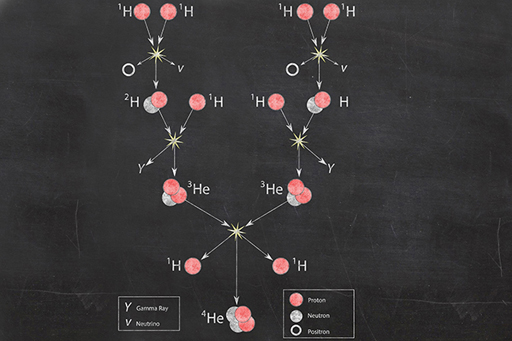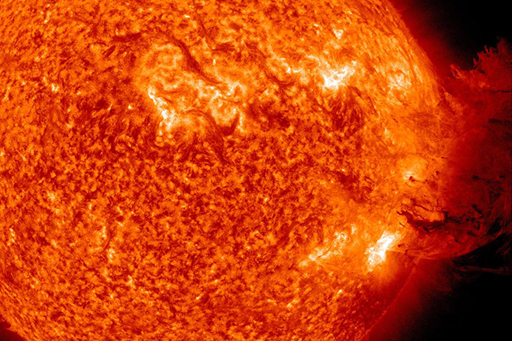2.1 What is a star?
The star closest to the Earth is, of course, the Sun, shown in Figure 1. Studying the composition of the Sun illustrates the composition of stars in general. The composition of the Sun is determined by the technique of spectroscopy – more about this later.
The Sun, as a typical star, is almost completely made from hydrogen and helium gas – about 98%. The remainder is decreasing amounts of every other known element, all the way up to the heaviest element, which is uranium.
The core of the Sun is undergoing a process called nuclear fusion, in this case, hydrogen burning. In the Sun, this process occurs in three stages. First, two hydrogen nuclei fuse together to make a single nucleus of deuterium (D). This then fuses with another hydrogen nucleus to form helium-3. Finally, two helium-3 nuclei fuse to form one helium-4 nucleus and two separate hydrogen nuclei. A huge amount of energy is also released in the process, which is what creates the heat and light that comes from the Sun.

The Sun, then, is a gigantic sphere with a core of burning gas. The core is about 50 times as dense as rock, and has a temperature of 15 million K. The surface of the Sun is much cooler, only about 5800 K!
You may not be familiar with the abbreviation ‘K’ to signify temperature. This stands for ‘Kelvin’, and is the international unit of temperature (it is given as K and not °K). A difference of 1 K is the same as a difference of 1 °C but the Kelvin scale starts from a different zero point. 0 °C corresponds to the temperature at which water freezes (at the Earth’s atmospheric pressure). 0 K, which is equal to −273.15 °C, corresponds to absolute zero where all motion of atoms stops, so 10,000 K is 9726.85 °C! The Celsius scale, which is generally used in everyday life, is more commonly used for biological environments, whereas the Kelvin scale is used for the wider temperature ranges found in astronomy.
The Sun is not an unusual star: it is about halfway through its life, and will continue to burn hydrogen for about another 4.5 billion years. More massive stars than the Sun are hotter, and burn their hydrogen faster, so have shorter lifetimes. You will learn about how long a star lives later this week, but before that, you need to know about how the brightness of a star is related to how far away it is, which you will learn about next.

